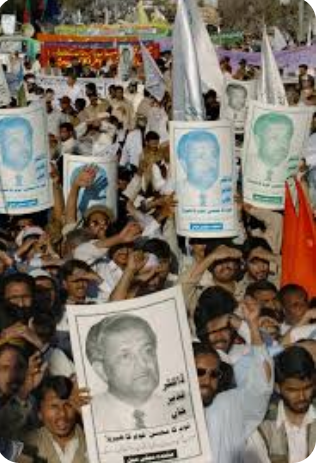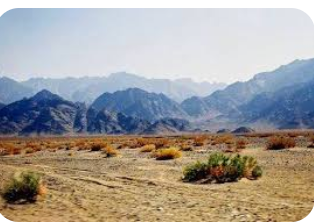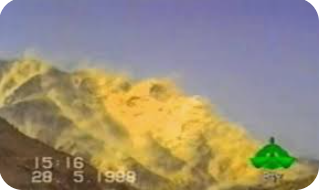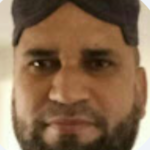From PIA plane hijacking to 'Allahu Akbar' chants in Chagai: When dust clouds obscure the face of the sun and black granite turns white
"Come on India," shouted the hijacker, placing a pistol on the pilot's cockpit.
 Caption
Caption
1.Pakistan International Airlines (PIA) Flight 544 had taken off from Turbat in Balochistan province just ten minutes before the pilot heard this threatening sound.
2.The destination of this Fokker aircraft, which took off from Turbat, was the city of Karachi in Sindh province.
3.According to Uzir Khan, the pilot of this plane, as soon as the hijacker's attention was diverted by a sound coming from the back of the plane, he pressed a button that sent a signal on the radar that the passenger plane was hijacked.
4.Later, Uzair Khan told in the documentary film 'Flight 544' that the hijackers had brought maps etc. He said just go straight. If you went straight, you would have come to the border of India. .
5.I said that there is insufficient fuel in the plane. He agreed to my request and said that the oil should be flown to New Delhi from the nearby Bhoj Airport in Indian Gujarat.
6.After receiving these orders from the hijackers, he says, "I turned close to the border and said ``Klo Delta'' in aerial language, the term used for the Pakistani city of Hyderabad. And listening to the hijacker, he asked the airport control whether it was Bhuj Airport (in India). The air traffic control had already realized that the Pakistan plane had been hijacked, so the answer was received from there that yes, it is Bhuj Airport.
7."Thus, assuring the hijackers of (the Indian city of) Bhoj, I managed to land at Pakistan's Hyderabad airport in the dark of night," he says. That's all I wanted.
8.This hijacking incident took place on May 24, 1998. A few days before this incident took place, i.e. between 11 and 13 May 1998, India had carried out several nuclear explosions and it was common knowledge that Pakistan could soon carry out retaliatory nuclear tests.
9.After landing at the Hyderabad airport, the Pakistani officers present there posing as Indian officials and after several hours of efforts, captured the three hijackers before dawn. Passengers and crew were not harmed in the entire incident. The arrested hijackers belonged to Baloch Students Organization.
10.According to Pakistani authorities and media reports of the time, the purpose of the hijacking on May 24, 1998 was to prevent Pakistan from carrying out tests in response to India's nuclear explosions.

According to a CNN report in May 1998, shortly before the hijacking occurred, there were reports that Pakistani authorities were preparing a site to conduct nuclear weapons tests in Balochistan. Anti-government demonstrations were also held by some parties.
The news was published on the front page of prominent newspapers across Pakistan the next day that the hijackers had made demands such as no nuclear tests in Balochistan and the provision of funds to Balochistan.The three thieves were subsequently condemned to death and draped in correctional facilities in Karachi and Hyderabad on 28 May 2015 (17 years since Pakistan's atomic blasts).
In any case, how Pakistan figured out how to direct atomic tests on May 28, 1998, we need to delve into the subtleties of the occasions that occurred a couple of days before this seizing occurrence.
"Congrats to Dr. Samar on India's impacts"
Picture inscription Dr. Samar Mubarak Mand (right) is invited back to Rawalpindi after the Chagai impacts
As per Dr. Samar Mubarak Mand, an individual from the Pakistan Nuclear Energy Commission, on the morning of May 11, 1998, a companion of his in the military called him and enlightened him regarding the atomic blasts did by India in Pokhran.
On November 30, 1998, while tending to an element of the Khwarazmi Science Society in Lahore, Dr. Mubarak Mand expressed that in the wake of hearing this, "I said 'Congrats.' I was truly blissful."
"He (military friend) said, 'You are congratulating us on the India experience?' I said yes because now we will also be able to experience our own."
According to Dr. Samar, in the year 1972, when the then Prime Minister Zulfikar Ali Bhutto gathered the country's scientists in Multan, there "we really swore to make nuclear weapons."
When India conducted its first nuclear test in Pokhran in 1974, Pakistan accelerated its nuclear program and after some time scientist Dr. Abdul Qadeer Khan also joined it from abroad.
By the end of 1980, the Kahota plant in Pakistan was completed and Dr. AQ Khan was put in charge of the plant. Earlier he was working as a scientist in this plant but later he became its in-charge.
In this context, after the explosions by India in May 1998, the international world had a strong possibility of Pakistan's reaction.
US President Bill Clinton had started efforts to stop Pakistan from nuclear tests 'under the threat of a nuclear conflict in South Asia'.
On November 30, 1998, in an event organized by the Khwarazmi Science Society in Lahore, Dr. Mubarak Mand said that "Immediately after India's experiments, as we expected, the Prime Minister of Pakistan had become active in this direction."

"They asked me, are you ready for this?"
"I said yes of course."
He said, 'Okay! Get ready.
On the other hand, US President Bill Clinton had started efforts to prevent Pakistan from nuclear tests 'under the threat of a nuclear conflict in South Asia'.
Douglas Franz and Catherine Collins in their book 'The Man from Pakistan' have covered these American efforts and Pakistan's actions in this regard.
He wrote that after India's experiments, Clinton telephoned Nawaz Sharif four times to emphasize restraint and offer concessions in exchange for not experimenting. Clinton promised to waive US debt, repeal the (anti-Pakistan) Pressler and Solars Amendments and get Congress to approve new military aid.
Adrian Levy and Catherine Scott Clark wrote in their book 'Deception' that in this regard, a high-level delegation led by Clinton's Deputy Secretary of State Strobe Talbot came to Islamabad on May 13 and the then Foreign Minister Gohar Ayub sent this delegation. mocked the offer of F-16 aircraft to Pakistan.

In an interview with the same writers in London in 2006, Nawaz Sharif said that 'Clinton called me five times to ask what we were doing, to get assurances that we would not conduct a nuclear test. will When Strobe Talbot came, he thought we would agree. Clinton thought so too. But only we knew what we would do.
Franz and Collins further wrote in their book that 'Three days after India's initial tests, CIA Director George Tenet told a closed-door meeting of the Senate and Congressional Intelligence Committees that satellites had detected Chagai in southwest Pakistan. In the mountains of the underground nuclear test preparationsGone.
Why was Chagai chosen for nuclear experiments?
Chagai, situated in the northwest of Balochistan region, is the biggest locale of Pakistan concerning region.
This district borders two countries, Afghanistan and Iran.

The nearly 200 km long mountain range 'Ras Koh' is the southern border of Chagai district. The hill chosen for the May 28 blasts is located in front of Chhatar village in the 344 square kilometer area of Dostanvadh at the foothills of this mountain range.
On the other side of Ras Koh, in the Kharan desert is the site where the sixth explosion took place on May 30.
Physicist Faizanullah Khan writes in his book 'Kahota Se Chagai Tak' that the mountain of Ras Koh in Chagai district was chosen because it was barren and relatively uninhabited. Such solid rock formations are most suitable for underground explosions, as they do not allow radiation effects to spread. This area was isolated from any land or air passage, so it could remain secret.
There were only a few hundred people living around it who could easily be evacuated before the explosion. Similarly, the second place was in the desert of Kharan on the other side of Ras Koh, where there was no population at all.
But who will do the test?
The American delegation was still in Pakistan when, according to Franz and Collins, an emergency meeting of Pakistan's National Defense Committee was convened on May 15, attended by Nawaz Sharif and his cabinet and senior military officers.

The matter had to be on two points: Should Pakistan conduct nuclear tests? And if it is to be done, will this test be done by Pakistan Atomic Energy Commission or Khan Research Laboratory?
In several hours of consultation, only [then] Finance Minister Sartaj Aziz expressed the fear of economic sanctions in case of you (Khan Research Laboratories).
According to Franz and Collins, Samar Mubarak Mand said that the commission had completed its preparations at Chagai and conducted simulated nuclear explosions, called cold tests, using conventional explosives instead of enriched uranium or plutonium. They said they need 10 days (for the hot test). On the other hand, Abdul Qadeer Khan said that it is his right to be in charge of experiments. He said that his lab has enriched uranium for devices and also conducted cold tests.
The meeting adjourned without any formal decision on when and who would conduct the tests. However, everyone agreed that India must respond. In the next two days, Nawaz Sharif decided in meetings with high-ranking officials of the army that the commission will conduct the test as soon as possible.

When the American delegation left, according to Rai Muhammad Saleh Azam, the chairman of the commission, Ashfaq Ahmed, met the prime minister and said to him: "You decide, inshallah I guarantee you success."
Rai Muhammad Azam has written in his book 'When Mountains Move: The Story of Chagai' that the next morning i.e. 18th May, the Prime Minister called him again and said: 'Explode it.'
Displeasure of Dr. Abdul Qadeer Khan
In the book 'The Man from Pakistan', it is written that Dr. Khan went to the Army House Rawalpindi to meet Army Chief General Jahangir Karamat to say that even if the experiments were not headed by his laboratory, he must have a role in them.
He argued that his lab's enriched uranium would be used in nuclear devices. He also pointed out that he had recently [April 1998] tested a missile [Ghori].
General Karamat said a KRL team may go to Chagai to finalize the preparations and Khan will be among the dignitaries invited to watch the experiments from a nearby bunker. The next day a small group of RLs accompanied the commission's scientists, engineers and technicians from two PIA flights. Supplies and equipment were escorted by four F-16s and two C-130s.
Faizan Khan writes that 200 people living near Chagai were moved to safe places before the explosions.
Franz and Collins wrote that "at Chaghi, the various parts of five nuclear devices were assembled at the end of a 3,000-foot-long fishhook-shaped tunnel." Diagnostic wires were attached to the devices that were to monitor the explosions.
"On the afternoon of May 26, the tunnel was sealed with 6,000 sacks of cement and 12,000 sacks of sand, and the next day engineers confirmed that the cement had dried enough to contain the explosion [in the tunnel]."
Mubarak Mand further said in his lecture that the Prime Minister told him, "Doctor, please don't fail." We cannot afford to fail. If we fail, we will not survive. This is a critical moment for Pakistan.
According to Franz and Collins, on May 28, Muhammad Arshad, a young officer designing the commission's triggering mechanism, was selected to push the buttons to operate the devices.
He initiated the process by saying 'Allahu Akbar' and on the same day at 3:16 in the afternoon five underground explosions shook Ras Koh at the same time. Clouds of dust hid the face of the sun and the black granite turned white.
All the scientists present there including Samar Mubarak Mand shouted 'Allahu Akbar'.
Dr. Mubarak Mand says, "We were able to do the first 5 blasts from a distance of about 15 km and the last blast on the 30th from a distance of 45 km."
I saw the miracle of teamwork in Chagai. We stayed there for about 10 days. Technical difficulties also occurred during these 10 days. We made collective decisions and solved problems. Team spirit was high. In such a responsible job there is bound to be tension, profanity, quarrels and bad tempers, but there we were all smiling, happy and relaxed.'
Adrian Levy and Kathryn Scott-Clark wrote that 'as she sat around, scientists, engineers and military officers, including Mubarak Mand, posed for photographs. AQ Khan stood out among them with his smiling face and towering stature. They did not even suspect the grudge that had been going on till now.
At 6 o'clock in the same evening, the Prime Minister of Pakistan, Nawaz Sharif, explained the details of the incident that took place in the mountain range in Chagai district in the northwest of Balochistan province through the official radio and television as follows: "Today we have conducted five successful nuclear tests. Now no nuclear night can kill us.
According to researcher Sadiqa Khan, Pakistan's sixth nuclear test was conducted two days later under the leadership of Dr. Abdul Qadeer Khan. It is as if Dr. Samar Mubarak was the head of the team of scientists who exploded Chagai One, while Dr. Abdul Qadir Khan headed Chagai Two.
Nawaz Sharif added in his address to the nation that 'We have paid the bill for India's nuclear tests of the past few days.'



You must be logged in to post a comment.